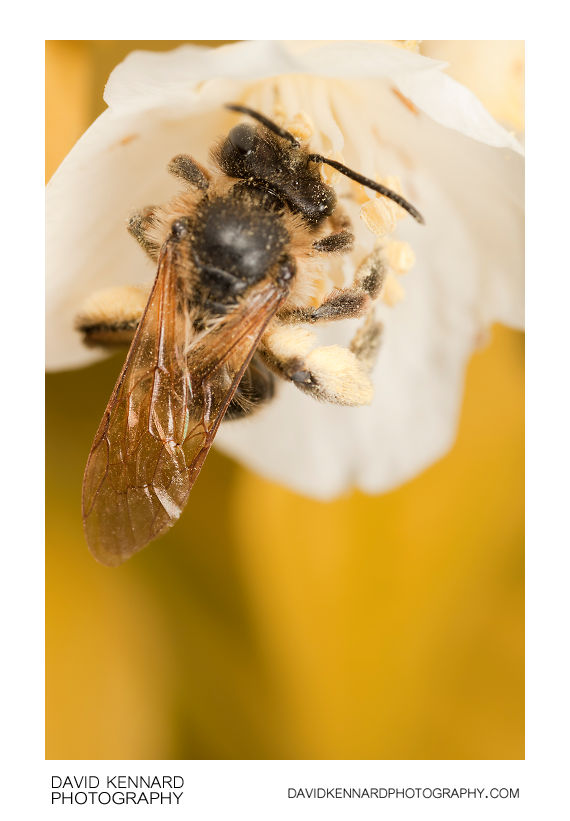Andrena sp. Bee

Description
- Title:
- Andrena sp. Bee
- Caption / Description:
-
An Andrena sp. Bee gets covered in pollen from a Golden Mock Orange (Philadelphus coronarius Aureus) flower.
From Wikipedia (http://en.wikipedia.org/wiki/Andrena):
Andrena is the largest genus in the family Andrenidae, and is nearly worldwide in distribution, with the notable exceptions of Oceania and South America. With over 1,300 species, it is one of the largest of all bee genera. Species are often brown to black with whitish abdominal hair bands, though other colors are possible, most commonly reddish, but also including metallic blue or green.
Body length commonly ranges between 8 - 17 mm with males smaller and more slender than females, which often show a black triangle (the "pygidial plate") at the abdominal apex. In temperate areas, Andrena bees (both males and females) emerge from the underground cells where their prepupae spend the winter, when the temperature ranges from about 20°C to 30°C. They mate, and the females then seek sites for their nest burrows, where they construct small cells containing a ball of pollen mixed with nectar, upon which an egg is laid, before each cell is sealed. Andrena usually prefer sandy soils for a nesting substrate, near or under shrubs to be protected from heat and frost.
Andrena females can be readily distinguished from most other small bees by the possession of broad velvety areas in between the compound eyes and the antennal bases, called "facial foveae". They also tend to have very long scopal hairs on the trochanters of the hind leg. Most species also have a well-developed "corbicula", or pollen basket, on the sides of the thorax; it is formed by an outer fringe of hairs and may or may not contain internal hairs.
- Tags / Keywords:
-
- Biota
- Life
- Vitae
- Eukaryota
- Animalia
- Animals
- Arthropoda
- Arthropods
- Insecta
- Insects
- Hymenoptera
- Bees
- Ants
- Wasps
- Andrenidae
- Andrena
- Pollen
- Pollen basket
Admin
- Date Original Photo Taken:
- Original File Name:
- _MG_1085.CR2
- Event:
- Rating:
- ☆
- Date this image added/last updated on website:
- Original File Dimensions:
- 2848px x 4272px
- File Type:
- JPEG
- Color Mode:
- RGB
- Original Image Color Profile:
- Adobe RGB (1998)
Location
- Location Created:
-
- Sublocation:
- City:
- Market Harborough
- Province/State:
- Leicestershire
- Country:
- United Kingdom
- World Region:
- Europe
- Geo-location:
Rights
- Copyright Status:
- Copyrighted
- Licensing Status:
- Rights Managed
- Available for Editorial Use:
- Yes
- Available for Commercial Use:
- Yes
- Copyright Notice:
- © 2010 Dave Kennard
Camera Data
- Date Digital Resource was created:
- Shutter speed:
- 1⁄200 s
- Aperture:
- f/8
- Camera Model:
- Canon EOS 450D
- ISO:
- 100
- Exposure Compensation:
- 0
- Focal Length:
- 65mm
- Focal Length (35mm equiv.):
- Metering Mode:
- Multi-segment
- Flash:
- On, Fired
- Exposure Mode:
- Manual
- White Balance:
- Manual
- Light Source:
- Exposure Program:
- Manual
Additional shooting metadata
- Lens:
- Canon MP-E 65mm F2.8 1-5x Macro
- Filters used:
- Additional Optics used:
- Setup:
- Handheld
Canon MT-24EX Macro Twin Flash with Home-made Concave diffusers
Post Processing
- Image Modified:
- Software used:
-
- Adobe Camera RAW
- Post Processing:
30 recovery in ACR
